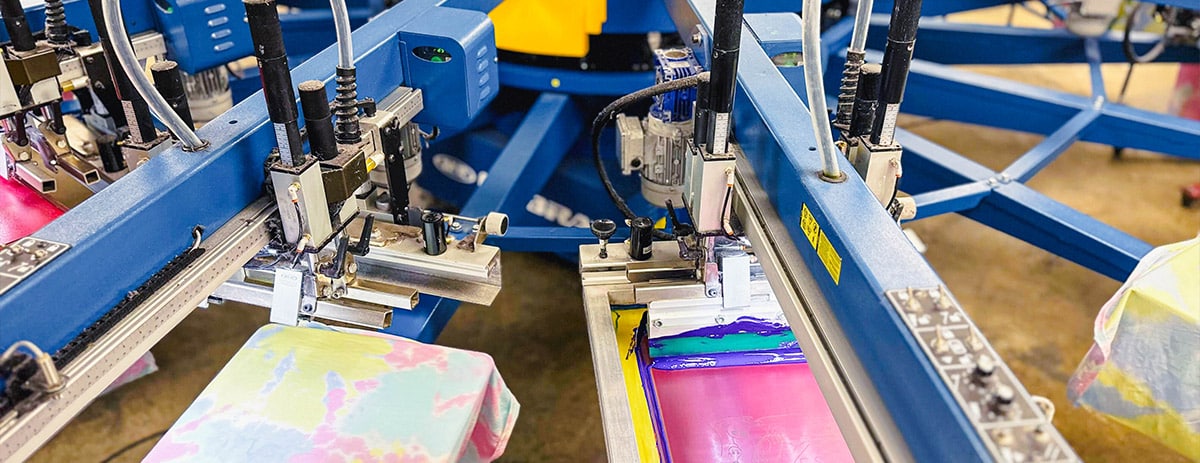Complete Screen Printing Kit for Artists and Creators
Complete Screen Printing Kit for Artists and Creators
Blog Article
Screen Printing Uncovered: Every Little Thing You Need to Learn About Tee Shirt and Garment Printing Strategies
If you've ever before questioned exactly how those dynamic designs wind up on your favored tees, you're in the ideal location. Display printing is a fascinating method that incorporates art with technique, offering endless opportunities for creative thinking. Recognizing the principles, from devices to ink selections, can significantly affect your outcomes. Ready to discover the essential components that make screen publishing an art form? Allow's reveal the information that can boost your tasks.
The Basics of Screen Printing: Just How It Works
When you dive right into display printing, you'll find it's both an art and a science. At its core, display printing includes producing a stencil, or screen, that enables ink to pass through only in specific locations.
Next, you'll mix your inks and prepare your printing surface. Position the screen over the textile, then use a squeegee to push ink with the display onto the garment. This procedure calls for accuracy, as you desire clear, vivid prints. After printing, you'll heal the ink with warm, guaranteeing it sticks to the material and lasts with washes. Each action is important, and mastering them will elevate your display printing skills, changing simple garments into special, expressive pieces.
Kinds of Screen Printing Methods
When you understand the essentials of display printing, it's time to check out the different strategies that can boost your layouts. One popular approach is typical display printing, where ink is pressed through a stenciled display.
If you're intending for fine information, take into consideration discharge printing. This method eliminates dye from the fabric, leaving a soft, classic look. Another choice is plastisol printing, recognized for its durability and brilliant colors, making it a favored for numerous brands. Experiment with halftone printing to produce slope results and intricate layouts. Each strategy has its unique appeal, so don't think twice to attempt them bent on discover what matches your style best!
Important Tools for Display Printing
To attain magnificent cause display printing, having the ideal equipment is basic. You'll require a tough display printing frame, which holds the mesh that moves your style onto the garment. Next, buy high-quality squeegees; these are essential for applying ink equally throughout the screen. You'll additionally require a great direct exposure system to create your displays, in addition to a washout cubicle for cleaning them after use. A dependable warm source, like a conveyor dryer or heat press, is essential for treating your prints to guarantee longevity. Do not fail to remember a proper workspace, furnished with tables and storage space for your supplies. Ultimately, safety gear, such as masks and handwear covers, will keep you safe from chemicals and inks. With the right tools, you'll be well on your method to generating professional-quality prints.
Choosing the Right Inks and Products
When picking inks and materials for screen printing, you require to think about the kind of ink that functions finest for your project. Consider fabric compatibility to ensure your designs look terrific and last lengthy. Explore environment-friendly ink choices to make your printing process a lot more sustainable.
Types of Screen Inks
Picking the ideal display ink is crucial for achieving vivid, sturdy prints that satisfy your job's needs. There are several kinds of display inks to examine. Specialty inks, such as glow-in-the-dark or metallic, can include distinct effects to your layouts.

Material Compatibility Considerations
Comprehending fabric compatibility is important for attaining premium display prints, specifically given that various materials react uniquely to different inks. Always test your inks on sample material to ensure they adhere properly and keep shade stability. In addition, keep in mind that textile weight and texture can impact the final result, so selecting the ideal ink and material combo is important for your job's success.
Eco-Friendly Ink Options
Environmentally friendly inks are becoming a preferred option for display printers who want to decrease their environmental effect while maintaining top quality. When choosing inks, consider water-based inks, which are less damaging and simpler to cleanse up compared to traditional solvents.
Furthermore, seek inks made from renewable energies, such as soy or vegetable-based options. By picking the right inks and materials, you'll not only produce stunning designs yet additionally add to a much more sustainable printing process. Make the switch, and your prints will show your commitment to the setting!
Preparing Your Style for Screen Printing

File Format Demands
To ensure your style looks sharp and vivid on material, you'll need to pay close focus to file layout demands for display printing. Make sure your design has a transparent history to prevent unwanted white edges on your prints. Maintain shade settings in mind; CMYK is standard for screen printing, so convert your RGB makes as necessary.
Color Splitting Up Strategies
Color splitting up is an essential step in preparing your style for screen printing, and mastering it can significantly enhance your print top quality. You'll require to break your design into individual shades, as each shade calls for a different screen throughout printing. This accuracy not only ensures accurate color representation but additionally streamlines the printing process.
Resolution and Size
Achieving the ideal results in display printing begins with assuring your layout has the appropriate resolution and size. Ideally, your art work needs to go to the very least 300 DPI (dots per inch) for sharp, clear prints. If you make use of reduced resolution, your last product might look pixelated and amateur.
When it concerns dimension, take into consideration the measurements of your print area. Design your artwork to match the final print size, ideally creating it in the actual dimensions you'll be publishing. In this manner, you'll stay clear of any type of unexpected scaling concerns.
Constantly examine your design in both vector and raster formats. Vector graphics can be scaled without losing quality, making them ideal for screen printing. Preparing properly will ensure your style looks remarkable on every garment!
Step-by-Step Display Printing Refine
Display printing is a dynamic process that enables you to develop vivid layouts on numerous surfaces. To get going, you'll require a display, emulsion, and your picked ink. Initially, prepare your screen by cleansing it completely. Next, apply the solution equally and let it dry in a dark area. When completely dry, subject your screen to light with your layout put on it, which will solidify the emulsion where the light hits, creating a stencil - screen printing kit.
Pour ink onto the screen and use a squeegee to press the ink via the pattern onto the textile. Lift the display thoroughly and allow the print dry. You have actually successfully display published your style.
Tips for Effective Display Printing Projects
While you're diving right into your display printing projects, bear in mind that prep work is vital to success. Beginning by gathering all your materials-- inks, garments, screens, and mops. A clean workspace helps stop unwanted errors, so clean prior to you start.
Next, confirm your artwork is high-resolution and correctly sized for your garment. Test your display for proper direct exposure custom screen printing and tidy it completely to avoid smudges. When blending your inks, adhere to the producer's standards to attain the right consistency.
During printing, apply also pressure with your squeegee for consistent results. Do not hurry; take your time to verify each print meets your standards. After printing, let your garments completely dry completely prior to taking care of or packaging them.
Lastly, constantly keep a sample of your help future recommendation. By doing this, you can examine your progression and improve your techniques with time. Pleased printing!

Frequently Asked Inquiries
Exactly how Long Does It Require To Establish a Screen Printing Task?
Setting up a display printing task commonly takes about half an hour to an hour. You'll prepare the displays, mix inks, and readjust journalism. The time differs based on intricacy and experience, so remain arranged!
Can I Print on Different Textile Enters Utilizing the Very Same Strategy?
Yes, you can print on various fabric kinds using the same method, but you'll require to change your inks and settings. Some materials absorb ink differently, so trying out warranties the very best results for each and every product.
What Prevail Mistakes to Prevent in Screen Printing?
When display printing, stay clear of typical errors like utilizing the incorrect ink, neglecting proper exposure times, or skipping pre-press checks. Constantly test your arrangement and keep clean screens to guarantee quality results each time.
Exactly How Can I Properly Tidy and Maintain My Screen Printing Devices?
To properly clean and maintain your screen printing tools, you should on a regular basis clean screens with ideal solvents, examine squeegees for wear, and ensure all devices are kept dust-free and dry. Uniformity improves and avoids pricey repair work efficiency.
Is Screen Printing Eco Friendly Contrasted to Other Techniques?
Display printing can be extra eco-friendly than other methods, especially if you make use of eco-conscious products and water-based inks. By selecting sustainable products and techniques, you minimize waste and reduce your influence on the planet.
Display Printing Uncovered: Every Little Thing You Need to Know Regarding Tee Shirt and Garment Printing Techniques
At its core, screen printing involves developing a pattern, or display, that permits ink to pass via only in specific areas. Setting the screen over the material, then make use of a squeegee to push ink via the display onto the garment. One prominent method is conventional screen printing, where ink is pressed via a stenciled display.When picking inks and materials for display printing, you require to take right into account the kind of ink that functions ideal for your job.
Report this page